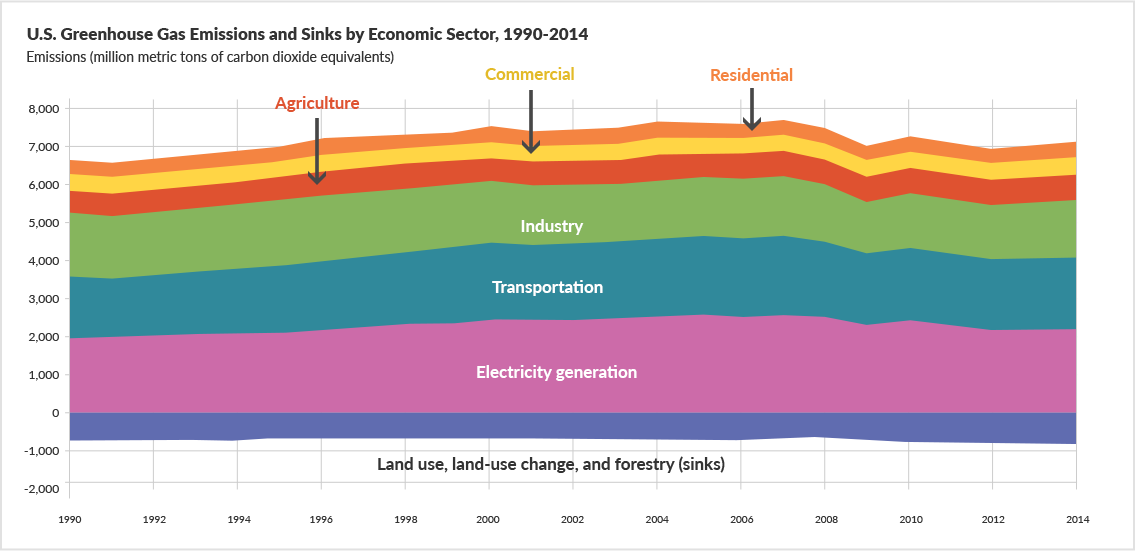In 2019, greenhouse gas emissions reached their highest point in recorded human history, according to the World Meteorological Organization. Driven by fossil fuel use, energy production has significant costs beyond what we pay on our power bills each month. Fossil fuels exact an associated price — on human health, climate change and environmental damage. Conversely, solar energy production has far fewer environmental and health impacts and is a renewable source of energy.
A 2013 study by the Clean Energy and Climate Change Office found that in order to reduce and avoid the large-scale environmental and health impact from fossil fuels, consumers should be willing to pay between $0.24 and $0.45kWh for alternative energy sources — such as solar.
This page outlines the total costs of fossil fuels and why solar energy is gaining market share as a realistic, safer alternative to traditional energy sources.
QUIZ: Is Solar Worth It To You?
-
1. Which of these best describes your motivation for considering solar for your home?
-
Reduce your carbon footprint
-
Save money on utility bills
-
Go off-grid
-
I’m not considering solar. I like traditional fuels and don’t think solar is worthwhile.
-
-
2. Does your state create a lot of CO2 emissions in electricity production?
-
HIGH
-
MODERATE
-
LOW
-
-
3. Which of these best represents your home energy use?
-
You’re an owl – using electricity, but using it wisely, keeping a sharp eye out for opportunities to conserve
-
You’re an energy hog – happy to wallow in cheap and easy electricity.
-
You’re a camel, and can survive for long periods without much energy
-
-
4. Which of these statements expresses your environmental commitment to future generations?
-
We must do all we can to pass on a clean, healthy planet to our children
-
They’ll figure it out; every generation does
-
Every man, woman, and child for himself
-
-
5. Do you believe global warming is real?
-
Yes, and human impacts are heating up the planet at an unprecedented, unacceptable rate
-
Yes, but it’s purely a natural cycle
-
No, it’s a hoax created to manipulate us
-
-
RESULTS:Restart
Hidden Costs of Fossil Fuels
Beyond the feel-good factors of going solar is only one aspect of how impactful choosing renewable energy can be for you. Everyday electricity choices can make a difference in your environment, finances, and health. Opting for clean, sustainable energy is a wise choice on many levels.
As the costs to produce renewable energies such as solar and wind have dropped in recent years, fossil fuel costs have held fairly steady, with the cost of producing natural gas climbing. The gap between fossil fuel and renewable energy production costs is narrowing. Meanwhile, the toll fossil fuels take on our health and environment are becoming steeper every year.
The International Energy Agency projects that the costs of fossil fuel production eventually will surpass those of renewable energy in the next decade.
How an Average Home Solar Array Impacts Fossil Fuel Consumption
Despite the increased use of renewable energy and its lowering production costs, fossil fuels have comprised about 80 percent of our total energy production in the U.S. since 1900.

Source: U.S. Energy Information Administration, Monthly Energy Review
The average U.S. home consumed about 10,972 kWh per year, according to 2018 data from the U.S. Energy Information Administration. The average household solar energy system size in the U.S is 6.2 kilowatts (kW), which is exposed to full sun from four to six hours per day. The average array falls a bit short of offsetting 100 percent of a household’s needs, but for the sake of argument, let’s say it does.
When comparing the environmental impact of using different energy types, the Environmental Protection Agency (EPA) uses metric tons of CO2 emissions per unit of energy as its yardstick.
According to the EPA, 10,972 kWh of electricity creates 7.8 metric tons of CO2 using national averages for fuel burned at U.S. power plants. (Your amount will vary based on your region.)
Annualized, 0.021 metric tons per day equals 7.6 tons of CO2 per year.
That’s equal to the CO2 released by the consumption of 18Fultimately barrels of oil.
In other words, an average household solar array offsets the equivalent of almost 18 barrels of oil per year.
Fossil Fuel Subsidies for Large-Scale Energy Producers
Subsidies are a central reason why adopting solar energy has been an uphill battle. Subsidies are a blend of financial, regulatory and political incentives that ultimately favor fossil fuels over other sources. Examples range from local governments selling or leasing land to energy companies at discount rates, to statewide tax incentives for energy production.
According to the U.S. Energy Information Administration, fossil fuels accounted for about 64 percent of the country’s electricity in 2018, or approximately 4 trillion kilowatt-hours. The three fossil fuels primarily used to generate electricity in the U.S. in 2015 are:
-
Coal
27.5% of total electricity generation
-
Natural Gas
35.2%of total
-
Petroleum
0.6% of total
Subsidies expand and protect the use of fossil fuels through tax incentives, land access, and production support. Oil Change International, a research and advocacy organization working to transition toward clean energy, categorizes subsidies for fossil fuels into the following groups:
Exploration – support for the discovery of new fossil fuel resources
Production – support to companies that produce coal, oil, and gas
Consumer – support for lower fossil fuel costs for consumers
(Source: Oil Change International)
The effects of subsidies on fossil fuel production are significant:
The United States offers 11 tax preferences to fossil fuel producers, totaling more than $4 billion annually (United States Treasury).
The governments of the G20 countries provide $444 billion per year in subsidies, financing and investment to support oil, gas and coal companies (Oil Change International).
In terms of post-tax subsidies, the United States is the world’s largest supporter of fossil fuel production (European Commission and International Monetary Fund).
Environmental Costs of Fossil Fuels
The cost of using fossil fuels hits much more than just our wallets. They take a serious toll on the environment as well. Fossil fuels emit greenhouse gases that capture heat and cause the planet’s temperature to rise, and they create harmful air, water and land pollution. The major greenhouse gases are:
-
Carbon Dioxide
Produced from the burning of fossil fuels (natural gas, oil and coal), as well as manufacturing, industry and agricultural processes
-
Methane
Emitted through the production and transportation of fossil fuels and agricultural processes
-
Nitrous Oxide
Produced during industrial and agricultural processes and burning of fossil fuels
-
Fluorinated Gases
Produced through industrial processes, creating extremely potent synthetic greenhouse gases.
Energy and transportation are the two primary ways in which we burn fossil fuels.
Since 1990, fossil fuel usage for energy production has released more than 54 billion metric tons of greenhouse gases into the atmosphere in the United States, according to the U.S. Environmental Protection Agency.

As the table below shows, the United States is the world’s second-biggest CO2 polluter, second only to China. (Table expressed in thousand metric tons of carbon, not CO2)

Health Care Costs of Solar vs. Fossil Fuels
The World Health Organization reports that degradation of air quality increases the risk of acute and chronic respiratory diseases (e.g. asthma), heart disease, risk of stroke and heart disease.
Known as particulate matter (PM), this type of air pollution includes a blend of liquid and solid droplets. Particles that are 10 micrometers or smaller in diameter (less than the width of a human hair), called PM10 particles, can get into human lungs and cause a range of serious health problems.
What Type of Damage Does Particulate Pollution Cause?
According to the U.S. Environmental Protection Agency, particle pollution can stain and even damage buildings, generate haze, increase acid levels in bodies of water and lead to environmental damage in soil, forests and crops.
PM10 pollution due to electrical energy production has fallen since 2000, according to the EPA. (Table in thousands of tons)

Yet, despite general air-quality improvements, the EPA reports that about 137 million people in the U.S. live in areas with pollution levels that still exceed national health recommendations. In the U.S., emissions from ground-level sources, including vehicles, rail and marine operations; residential and commercial heating and industrial smokestacks lead to 200,000 premature deaths each year.

Road transportation emissions cause 53,000 premature deaths annually.
Power-generation emissions cause 52,000 premature deaths annually.
In Baltimore, 130 out of every 100,000 residents are projected to die annually due to long-term exposure to air pollution. (Source: Massachusetts Institute of Technology)
If no changes are made, 6.6 million people could die prematurely from air pollution each year by 2050. (Source: Netherlands Health Journal)
Approximately 91 percent of the world’s population reside in areas where the air quality far exceeds healthy limits established by the World Health Organization. (Source: WHO)
An estimated 7 million people die every year worldwide from air pollution. (Source: World Health Organization)
Coal plants generate nearly 130 million tons each of toxic ash each year. (Source: Toxic Action Center)
What’s the Complete Cost of Electricity?
On average, it costs residential and commercial consumers a little less than $0.13 per kilowatt-hour to purchase energy produced by fossil fuels. However, when you take the environmental and human health factors into account, the national health impact from fossil fuel ranges between $0.14 and $0.35/kWh.
Coal: $0.19 – $0.45/kWh
Oil: $0.08 – $0.19/kWh
Natural Gas: $0.01 – $0.02/KWh
(Source: Environmental International Journal)
The total economic value of the health impacts of using fossil fuels is anywhere from $361 to $885 billion annually, which represents up to 6 percent of the country’s GDP.
The total cost of using fossil fuels? The International Monetary Fund says it’s $5 trillion, which is the total of global energy subsidies, including social and environmental costs, which are exacerbating pollution and discouraging renewable energy investment.
Solar Energy Economic Impact
During the past 18 years, solar energy has grabbed a larger market share of total energy production in the U.S. In the past decade, the total amount of megawatt hours of energy generated by utility scale solar photovoltaic production has skyrocketed, as shown in the table below (in thousand megawatt hours).

Source: U.S. Energy Information Administration
Solar Energy Price Drops
During the past 18 years, solar energy prices have fallen, leading to an increase in rates of installation.

The amount of total installed solar PV capacity in the United States is expected to double by 2024. (Source: Solar Energy Industries Association)
As of the first quarter 2019, the U.S. had an estimated 69.1 gigawatts of solar installed, which is enough to generate power to 13.1 million homes. (Source: Solar Energy Industries Association)
Over the last decade, solar prices have decreased by 70 percent. (Source: Solar Energy Industries Association)
Bloomberg New Energy Finance expects solar PV costs to decrease by 60 percent by 2040. (Source: Bloomberg New Finance)
Nationally, the average per watt cost to install residential solar is $3.70. (Source: Berkeley Laboratory)
Interview with David Feldman: Energy Economist Compares Energy Production Costs
Feldman shares his thoughts about the true costs of using fossil fuels and what he projects for the future of solar energy.
Limiting climate-change damages through reductions in greenhouse gas emissions by relying more heavily on solar power will have an extreme impact. A recent study funded by the Department of Energy found that “achieving the SunShot Vision scenario [of solar cost reductions] reduces life-cycle GHG emissions from the power sector by 13 percent in 2030 and 18 percent in 2050. … These reductions produce global benefits of $259 billion in the form of lower future climate change damages when applying a central value for the social cost of carbon (SCC), which is equivalent to a levelized benefit of solar of 2.2¢/kWh-solar.”
There have been a variety of factors that have decreased the cost of PV modules over the past five to 10 years; these include a scale-up in manufacturing and supply chain, which has in turn lowered material costs, efficiencies in manufacturing through “learning by doing” and more efficient processes, and technology improvements that have increased the efficiency of PV cells and other components.
Looking forward, most companies have plans for further technology improvement, and through government and private-sector support, scientists around the world are researching and developing new methods for further improving the performance and lowering the cost of PV modules.
Already, PV has won competitive bids over natural-gas-generation plants in several parts of the world, including the U.S. With regard to oil, PV is in most cases already more competitive than oil in the electricity-generation sector; however, because of the intermittent nature of solar energy generation, it relies on other technologies, including storage, for a balanced delivery of electricity. As PV and battery costs decline, these technologies have further potential to outcompete oil in the transportation sector and the commercial and industrial sector as well.
The number of solar jobs has increased each year during the past five years.

Source: The Solar Foundation
While there will be short-term contractions within the solar industry due to policy changes or market conditions, the continued decrease in costs coupled with support from state and federal policies, such as the Clean Power Plan and State Renewable Portfolio Standards, should help solar continue to grow, and its employee base to grow with it. However, this is all dependent on continued state and federal support for deployment, including research and development.
In 2015, utility-scale solar produced 0.57 percent of electricity generated in the U.S., and at the end of the year, it had a capacity of 11.6 gigawatts. There is a tremendous amount of open land in the U.S., more so than in some other countries in the world. Therefore, we are more likely to have a higher percentage of large-scale plants in the U.S. than a space-constrained country like Japan or even Germany. That said, there are certain environmental, regulatory and feasibility challenges to installing PV systems above a certain size.
Solar Economics Resources

The Solar Foundation is a nonprofit organization that conducts research into solar energy, its impact on employment and the overall economic trends in the industry.

This government organization is dedicated to protecting the environment and human health, conducting research into areas such as air pollution and fossil fuels.

The IPCC is an international body that assesses science around climate change, including studies into solar and other renewable energies.

The NREL is a research organization focused on renewable energy, conducting research into solar through its National Center for Photovoltaics.

A national trade association with 1,000 members, the SEIA advocates for the installation, building and adoption of solar energy.

The government’s official energy statistics agency, the EIA provides in-depth information into electricity generation, consumption and production — including solar energy.
















